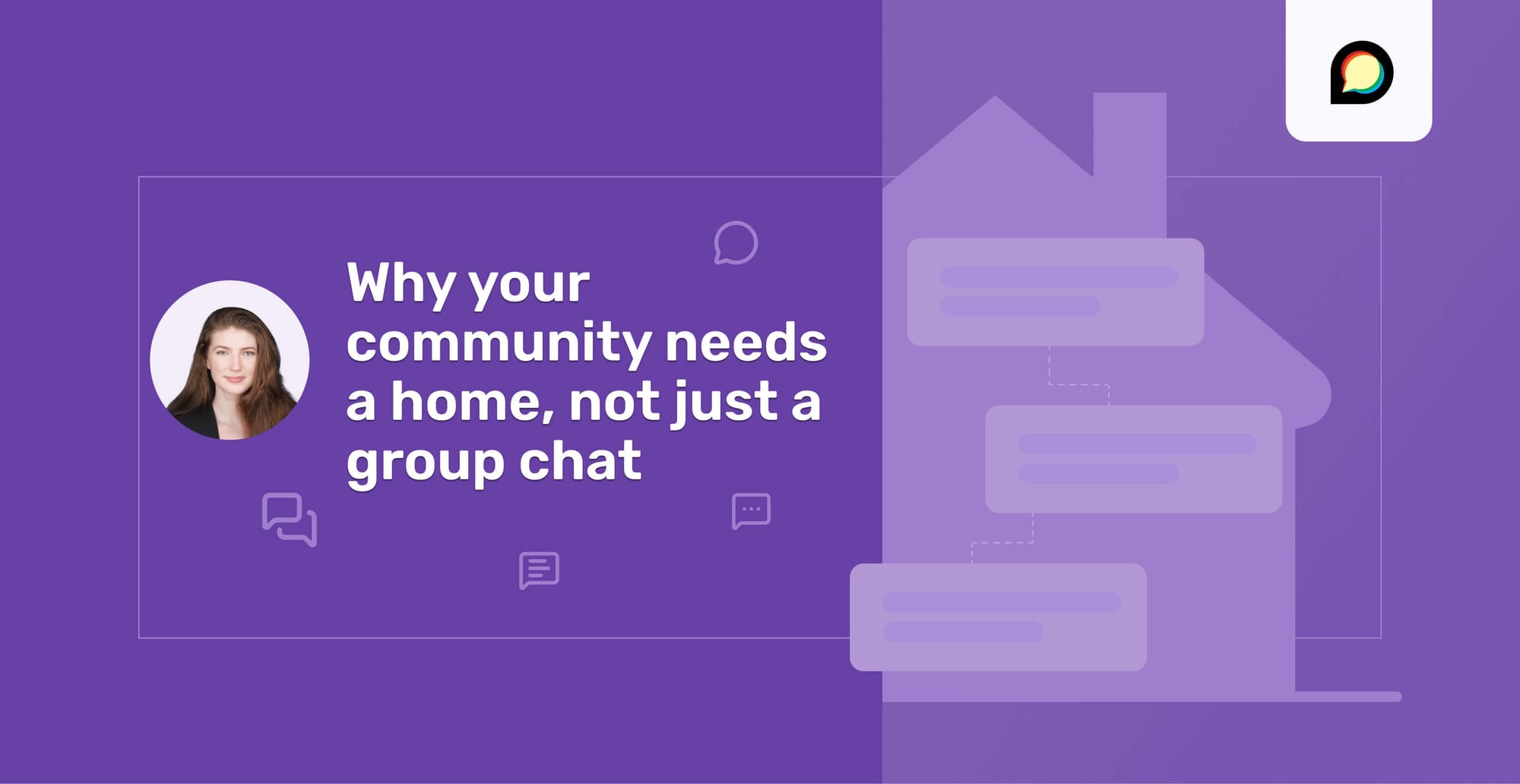Why Your Community Needs a Home, Not Just a Group Chat

We all crave connection. And when we want to bring people together, the easiest option is to spin up a group chat. It feels natural — everyone’s already on their phones, and the barrier to entry is basically zero. But if you’ve ever tried turning a Slack, Discord, or WhatsApp group into a real community, you’ve seen the trade-off — speed and convenience come at a cost.
The Group Chat Illusion
It’s not hard to see why so many communities start in a group chat. These tools give you instant connection, take only minutes to set up, and feel as familiar as texting a friend. At first, the energy is exciting. Messages happen instantly, people chime in, and it feels like you’ve built something real. But over time, reality sets in. Notifications pile up, conversations blur together, and what felt like a thriving chat turns into either a noisy stream no one can keep up with or a quiet room where no one bothers to check in.
Why? Because a group chat isn’t the same as a community home.
One is a temporary hangout; the other is a space built to last.
What Makes a Space Feel Like Home
What makes a community space different is its sense of permanence and stability. Members know their contributions won’t just vanish in a scrolling feed, but they’ll continue to matter next week, next month, next year. Instead of one endless thread, there are organized spaces and topics that keep discussions clear and accessible over time. This structure creates a shared memory, where people can revisit past conversations, learn from them, and build on them together. When the space itself reflects the community’s culture via design, features, and rituals, it stops being just another chat — and it becomes a home.
The Lifecycle of a Group Chat
Every group chat follows the same arc. It starts with energy and good intentions, but sooner or later, the cracks start to show. You’ve probably seen this pattern play out.
- Phase 1: Excitement - Every new group chat starts with an enthusiasm boost. Messages fly, intros are made, and it feels like the community is buzzing with possibility.
- Phase 2: Chaos - Then, the floodgates open. Important updates get buried, conversations overlap, and the pace becomes impossible to follow.
- Phase 3: Fragmentation - Side conversations break off into smaller groups. Some people stay active, others disengage, and the unified “everything” chat starts to splinter.
- Phase 4: Decay - Participation drops. Either the group goes silent, or the noise becomes so overwhelming that most people mute notifications.
- Phase 5: Abandonment - Eventually, the search for a “better” solution begins. The group chat is either left behind or left to stagnate.
This cycle is so common it’s almost predictable. Group chats can be the catalyst for connection, but they rarely sustain it. If you want your community to last more than a few months, you need to give it a home.
What Gets Lost in Transit
When communities live only in group chats, so much of their value slips through the cracks. Knowledge, decisions, lessons learned, and collective wisdom all get buried in endless scrolls of messages. New members show up pre-overwhelmed with no easy way to catch up on context or culture, leaving them feeling like outsiders. Deep discussions that deserve space for thought get reduced to scattered replies, while opportunities for members to develop expertise and be recognized for it never quite take shape. Even the community’s culture, its inside jokes, references, and traditions, tend to mutate and become unstable instead of building over time. Without a dedicated home, the threads that hold a community together unravel.
The Psychology of Belonging
Humans don’t crave place. We crave belonging. Psychologists and anthropologists have been talking about our territorial instinct for years, recognizing that belonging deepens when there’s a stable space to return to. In a recent study, Oregon State University found that a strong feeling of community belonging is strongly tied to better physical and mental health, but also because people feel they can actively participate, be safe, and matter in their community.
We also invest more in spaces we help shape, thanks to what behavioural economists call the “IKEA effect” — a psychological phenomenon where people place more value on things they’ve helped create. Research shows that when we assemble or build something ourselves, even if it’s imperfect, we feel more proud than if it came ready-made.
The same is true for online communities. When members believe they contributed to shaping features, and norms in a community, it boosts their sense of ownership and, correspondingly, their engagement and loyalty.
Structure Enables Freedom
It might seem counterintuitive, but boundaries and organization actually create more freedom in a community. Without structure, conversations get lost in a blur; with it, members can easily discover the discussions most relevant to them. Topic-based organization keeps conversations focused, allowing deeper, higher-quality exchanges instead of scattered chatter. Clear structure also makes moderation more effective, and community standards are easier to uphold when content has a natural place to belong.
Most importantly, structured spaces can scale. A group chat collapses under the weight of growth, but a well-designed community can welcome more members without losing its sense of clarity and connection.
When Group Chats Work (And When They Don’t)
Group chats absolutely have their place. There’s a reason chat is part of Discourse. They’re built for quick coordination, casual bonding, and urgent updates that need immediate attention. But when communities rely on chat for everything, the problems are inevitable and predictable. Once you cross a certain number of members, the noise is unmanageable and meaningful conversations will get buried. That’s why the most successful communities use a hybrid model: a permanent space for organized and lasting discussions paired with chat for those fast, in-the-moment interactions.
Building Your Community’s Home
Culture doesn’t happen by accident; it grows from norms that encourage depth over speed and meaningful discussion over noise. Just like a well-built house, your community should be designed with the future in mind, meaning spaces need to be able to adapt and evolve as more people join, without losing the sense of belonging that made it special from the start.
✅ Community Home Checklist:
- Clear structure: organize topics so members always know where to go.
- Thoughtful onboarding: guide newcomers with context and culture cues.
- Defined norms: encourage meaningful participation over fast replies.
- Scalable design: plan for growth without sacrificing clarity or intimacy.
- Cultural touchpoints: rituals, language, and traditions that make the space feel alive.
The Migration Strategy
Shifting from a group chat to a community space doesn’t happen overnight, and it’s a transition that needs to be planned with care. The whiplash of a sudden platform and culture shift can drive members away if they feel like they’ve lost their tribe.
Start by mapping out practical steps for moving your existing group: seeding initial discussions, inviting key members first, or introducing the new platform gradually. You should expect some resistance. People stick with what feels familiar even when the old tool clearly isn’t working. That’s why parallel operation often helps — running both systems for a time so members can ease into the change.
Don’t forget to preserve valuable content from the chat, capturing decisions, resources, or conversations worth keeping. Most importantly, recognize that migration isn’t just technical, it’s cultural. Members will need encouragement and modelling to shift from quick back-and-forth to intentional, lasting engagement. They need to know why, where and how.
Case Study: Why Okteto Moved From Slack to Discourse

Okteto, a DevX innovator founded by Ramiro Berrelleza, set out to help software teams ship faster by automating their development experience. From the start, Ramiro knew that building a strong community was crucial to his vision. Okteto initially turned to Slack for its familiarity and quick communication features, but the limitations soon became clear. Valuable discussions and knowledge lived only within Slack’s closed environment - unsearchable, unshareable, and almost instantly lost. As Ramiro put it, “the work of our community, maintainers, and teammates” risked going to waste.
Okteto’s move to Discourse provided both community continuity + lasting value: conversations became searchable, linkable, and open to anyone with an internet connection. Ramiro emphasizes how powerful it is that any member can post best practices today and know it will remain available tomorrow…
Home Ownership vs. Platform Tenancy
Building your community on a chat platform is like renting an apartment; you’re at the mercy of someone else’s rules. If the platform changes policies, raises prices, or even shuts down, your community can be left scrambling. Data portability becomes a lifeline, ensuring that the conversations, knowledge, and relationships you’ve built aren’t trapped or lost.
Community ownership gives you the freedom to customize and shape the space to reflect your community’s needs rather than fitting into a one-size-fits-all template. While there are costs to consider, the long-term economics favour owning or co-owning your infrastructure, especially when weighed against the risk of instability. Independence gives you control over your data, your design, and your member experience without surprise changes or limitations.
Signs Your Community Needs a Real Home
How do you know when it’s time to move beyond a group chat? The signs are usually clear if you know where to look:
- Members start voicing the same frustrations
- Too many notifications,
- Important updates are getting lost
- Growth slows down because new members feel overwhelmed and can’t catch up on context.
- Valuable knowledge slips away as decisions and insights vanish into the scroll, leaving people to repeat the same questions.
- The quality of engagement declines, with quick reactions and shallow comments taking the place of thoughtful discussion.
When these patterns appear, the writing’s on the wall. Your community has outgrown its chat and needs a real home to thrive.
The Long-Term Vision
The real power of a permanent community space is the way it creates compound interest — every conversation, resource, and connection adds value that grows over time instead of evaporating in a feed.
Community building means legacy building, creating something that will outlast any single member or leader. Done right, a community becomes a knowledge ecosystem, a resource for its entire domain.
It comes down to a choice: do you want to build something temporary, or do you want to build something that lasts?
